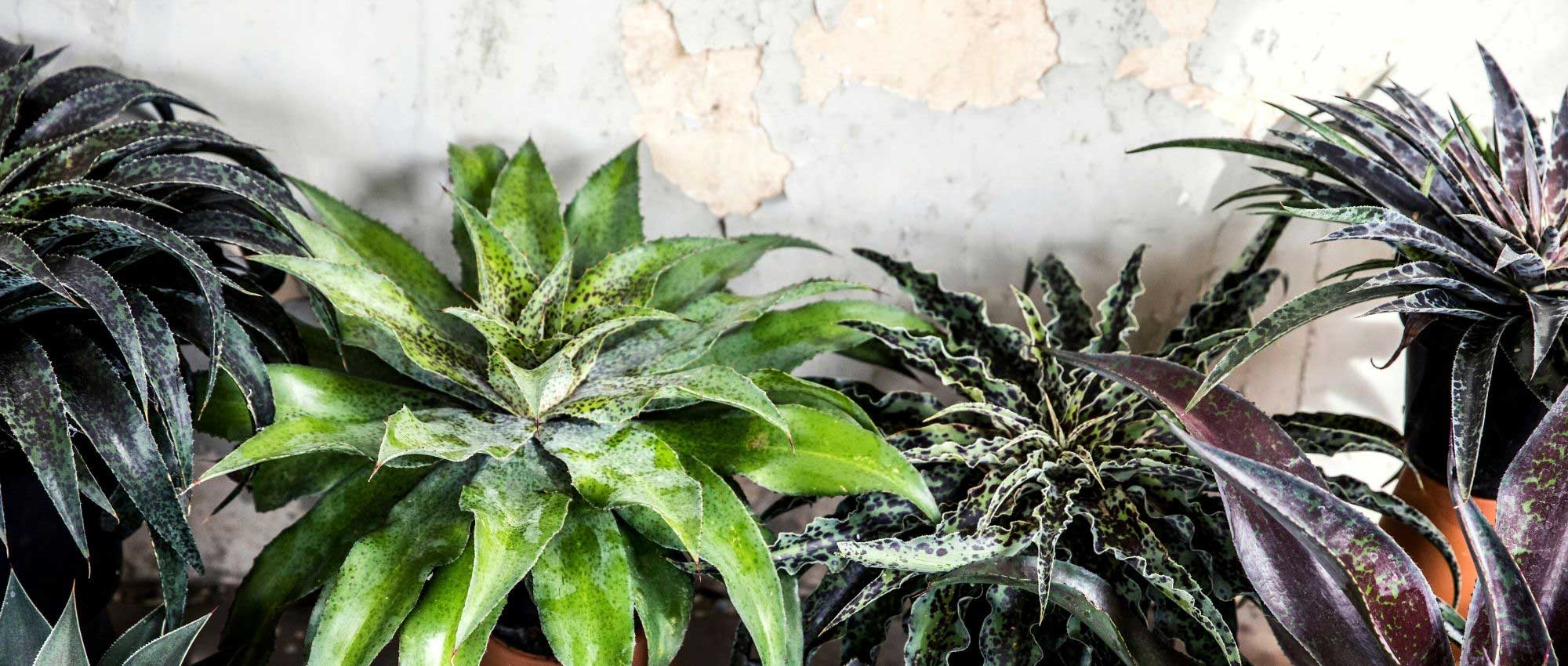
Mangave: Planting, Growing, and Care
Contents
Mangaves in a nutshell
- Mangaves are original and rare succulent plants!
- They form rosettes of thick leaves, like agaves, and are often speckled with purple.
- We appreciate their striking patterns and exceptional hues!
- Like other succulents, Mangaves are very drought-resistant and require little maintenance.
- They are not very hardy, but adapt well to pot cultivation, needing to be brought indoors for winter.
- They easily find their place in pots on a sunny terrace!
A word from our expert
Mangaves are original and rare succulent plants. They result from a cross-breeding between a Manfreda and an Agave, and are still relatively unknown. They have inherited the spotted and purplish patterns of Manfreda, as well as the evergreen and imposing character of agaves. Mangaves offer great diversity in terms of their patterns, colours, and leaf shapes. Their leaves appear to be injected with pigments in quite an irregular manner! They look like true works of art. Discover, for example, the Mangave ‘Pineapple Express’ with dark green leaves punctuated with purple, the variety ‘Lavender Lady’, which has solid leaves of a beautiful bluish-violet hue, or ‘Mission to Mars’, with beautifully purplish-red leaves. Mangaves grow a bit faster than agaves, thanks to their relationship with Manfreda. Unlike agaves, they don’t really have thorns! The leaves are slightly dentate, but with quite soft and non-spiky teeth.
Mangaves require a rather dry substrate, very well-drained, even sandy or gravelly. Generally, they do not tolerate temperatures dropping below -5 °C. If you live in a frost-free region, you can plant Mangaves in a dry garden alongside cacti, opuntias, and other xerophytes. However, in cooler regions, we recommend growing them in pots on the terrace or balcony, bringing them indoors for the winter.
Botany
Botanical data
- Latin name Agave sp.
- Family Asparagaceae
- Common name Mangave
- Flowering summer
- Height generally between 20 and 50 cm tall
- Exposure full sun
- Soil type perfectly drained, rather poor
- Hardiness -5 °C
Mangaves are the result of hybridization between Agaves and Manfreda, two succulent plants native to the southeastern United States and Central America. They have taken the best traits from both parents: the rapid growth and interesting patterns of Manfreda, along with the elegance, imposing and highly graphic nature, and evergreen character of Agaves. They have the advantage of growing much faster than Agaves and being less spiny.
Manfreda and Agaves are two very closely related succulent plants; in fact, Manfredas have recently been reclassified into the botanical genus Agave. Thus, Mangaves, which previously had their own scientific name x Mangave, naturally inherit the same genus name as their parents, Agave… although their nickname “Mangave” remains useful for distinguishing them!
Mangaves therefore belong to the same botanical family as Agaves, that of Asparagaceae. This family includes many exotic plants, such as Chlorophytums, Dracaena, Eucomis, Yuccas, as well as hostas, hyacinths, muscaris, Polygonatum…
The first cross between Agave and Manfreda took place in the 1990s from seeds collected from a Manfreda variegata in Mexico by Carl Schoenfeld, owner of the Yucca Do Nursery in Texas. Among the seedlings, two young plants exhibited characteristics of Agaves, particularly in their size and the rigidity of their leaves. The Manfreda from which the seeds were collected had actually hybridized with a nearby Agave celsii. The nursery named it Mangave and introduced it in 2005 under the variety name ‘Macho Mocha’, which quickly became very popular.
Meanwhile, Hans Hansen, who was working on hybridizing hostas in the lab, began experimenting with the hybridization of Agaves and Manfredas. He thus created many varieties of Mangaves (‘Inkblot’, ‘Pineapple Express’, ‘Mission to Mars’…), which were successfully marketed. Today, there are 40 varieties!

Mangaves offer a beautiful diversity: here, the varieties ‘Lavender Lady’, ‘Inkblot’ and ‘Moonglow’
Mangaves often form small rosettes 20-50 cm in diameter, with a height of 20-30 cm. However, this also depends on the varieties and their age. The largest can reach 80 cm in diameter or even more! They are particularly graphic plants that form rosettes of elongated, fleshy, thick leaves, somewhat like Agaves. They have a beautiful central symmetry and resemble the tuft of leaves atop pineapples. Their leaves are larger than those of Manfreda. In terms of shape, the leaves can be very thin or much wider, and they can also be undulate. They are often arched, trailing, and generally slightly dentate along the edge of the lamina. However, their thorns are not as sharp and dangerous as those of Agaves. The Mangave ‘Tooth Fairy’ has very decorative, reddish-orange teeth.
Mangaves have rather dark leaves: they are most often green speckled with purplish-brown spots, wine-coloured… They are covered with a waxy film, giving them a slightly bluish hue. It is often difficult to define the colour of Mangaves, as their hue ranges between bluish-grey, reddish-purple, and brown… These are not light and defined colours. The patterns are quite variable: the leaves can be almost entirely coloured or have only spots or small dots. The colours can vary depending on the season: the sun and UV rays give Mangaves much more intense colours… Thus, the Mangave ‘Macho Mocha’ tends to redden in summer.
Mangaves offer extraordinary diversity! The variety ‘Lavender Lady’ has a rather bluish-violet hue, with very elegantly shaped, beautifully tapered leaves. Sometimes the leaves are truly trailing, cascading, as seen in the variety ‘Bad Hair Day’. The effect is very pretty when this Mangave is placed in a large pot or basin, with the leaves trailing over the edge. But the most original is undoubtedly the Mangave ‘Chocolate Chip’, which has fine, very undulate leaves speckled with purple spots. The Mangave ‘Espresso’ is also very original: it has reddish-green leaves, variegated with two broad yellow bands along the edge of the lamina… reminiscent of the foliage of the Agave americana ‘Variegata’. Even though its leaves are softer and more spreading. The Mangave ‘Kaleidoscope’ boasts beautiful colours of green, yellow, and red.
The leaves of the Mangave are evergreen in winter. It retains this characteristic from Agaves, while Manfredas are generally semi-evergreen.

Mangaves ‘Cherry Chocolate Chip’, ‘Kaleidoscope’ and ‘Bloodshot’ (photos cultivar413 / Scott)
It takes several years for Mangaves to reach maturity before they begin to flower. Flowering occurs in summer, between July and October, depending on the varieties and the climate. When they bloom, they produce a tall, thick flower spike in the centre of the rosette. Once it reaches a certain height, it stops growing and reveals delicate small yellow or white flowers, grouped in a panicle. The flowering can reach heights of 1.5 m to 2 m!
Sometimes Mangaves produce bulbils (young seedlings) along the flower spike. They can simply be detached and replanted to obtain new plants.
Unfortunately, Mangaves are not very hardy plants: they do not tolerate temperatures below -5 °C. However, some varieties are more resistant: for instance, the Mangave ‘Macho Mocha’ can withstand temperatures between -10 and -12 °C in well-drained soil. If you live in an area where the risk of frost is very low, you can plant them in the ground; elsewhere, they should be planted in pots and brought indoors for the winter.
The main varieties of Mangave
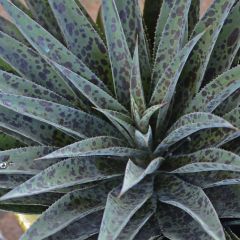
Mangave Pineapple Express
- Flowering time September to November
- Height at maturity 25 cm
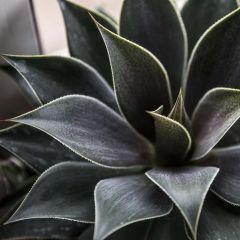
Mangave Lavender Lady
- Flowering time September to November
- Height at maturity 20 cm
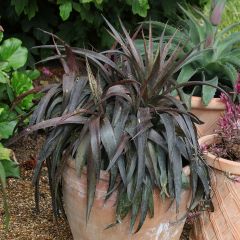
Mangave Inkblot
- Flowering time September to November
- Height at maturity 20 cm
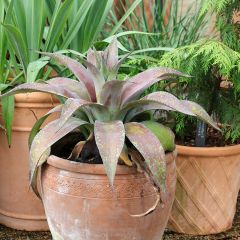
Mangave Mission to Mars
- Flowering time September to November
- Height at maturity 25 cm
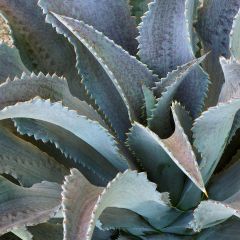
Mangave Silver Fox
- Flowering time September to November
- Height at maturity 30 cm
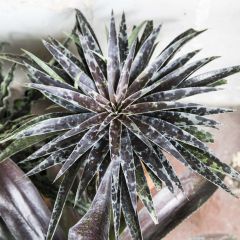
Mangave Moonglow
- Flowering time September to November
- Height at maturity 25 cm
Discover other Mangave
View all →Available in 0 sizes
Available in 1 sizes
Available in 2 sizes
Available in 2 sizes
Available in 2 sizes
Available in 2 sizes
Available in 2 sizes
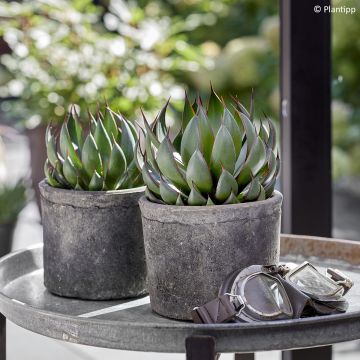
Available in 1 sizes
Available in 1 sizes
Available in 1 sizes
Planting
Where to plant?
The Mangave is a rather tender plant: if you live on the Côte d’Azur or the Breton coast, and the risk of frost is very low, you can plant it in the ground; otherwise, in the rest of the country, it is better to grow it in a pot. This way, you can take it out onto the terrace in spring and bring it back in autumn to protect it from the cold. It actually grows very well in a pot! It is a plant that enjoys full sun and well-draining substrates. However, in the south of France, where the sun is scorching, it is better to plant it in partial shade, while in the rest of the country, place it in full sun. Direct sunlight gives Mangaves a more intense colour, often more red. A Mangave grown indoors all year round will be less colourful! They are not very demanding in terms of mineral elements and tolerate poor soils very well, even stony or sandy ones. The most important thing is that the substrate is well-draining. Don’t hesitate to add gravel or coarse sand. If you plant them in the ground, you can also plant on a mound or create a raised rockery to allow water to drain easily. The Mangave will better withstand cold temperatures if the soil is well-draining and does not retain moisture.
When to plant?
We recommend planting the Mangave in spring, around May.
How to plant?
In the ground:
Opt for planting in the ground only if you live in a region where the risk of frost is very low.
You can place it under an eave to shelter it from rain in winter. It is also beneficial to plant on a mound or in a raised rockery to allow for better drainage.
- Dig a large planting hole.
- Add a mixture of coarse sand, potting soil, and garden soil in equal proportions.
- Gently remove the Mangave from its pot and plant it carefully.
- Replace substrate all around, ensuring not to bury it too deeply, and gently firm it down.
- Wait at least 15 days before watering. This way, if any roots were damaged during planting, it will give them time to heal and reduce the risk of rot.
In a pot:
Preferably choose a large terracotta pot, as it will breathe better and dry out faster than a plastic pot. It should also have drainage holes at the bottom to allow water to escape.
- Place a drainage layer at the bottom of the pot, made of clay balls, pumice, or gravel, for example.
- Fill the pot with special cactus potting soil, or a mixture of one-third coarse sand, one-third potting soil, and one-third garden soil.
- Plant the Mangave well in the centre, and replace substrate around it to secure it, then firm it down. However, be careful not to bury the collar too deeply, or it may rot.
- Wait at least 15 days before watering.
→ Learn more about growing Mangave in a pot in our advice sheet!
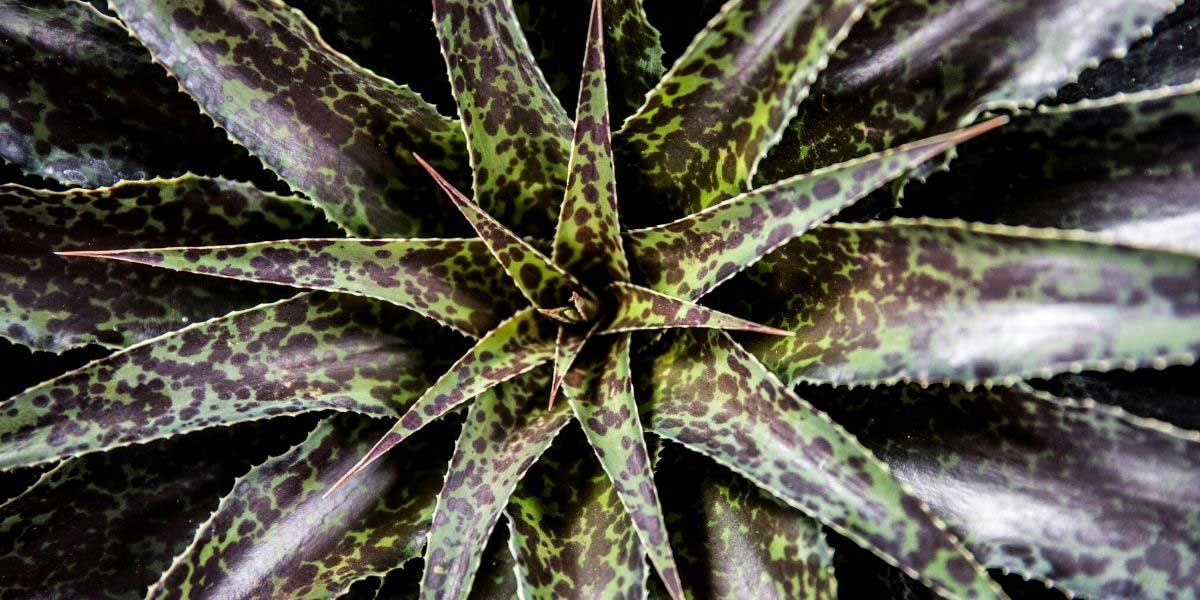 The maculate purple foliage of the Mangave ‘Inkblot’
The maculate purple foliage of the Mangave ‘Inkblot’
Entretien
Mangaves, like other succulent plants, are very drought-resistant and require little maintenance. Their thick leaves allow them to store water and minerals. Thus, they have minimal nutritional needs and adapt well to poor soils. Don’t hesitate to apply a mineral mulch around the young plant.
It is really important to let the soil dry out between waterings. Like other succulents, the Mangave is sensitive to excess moisture! In summer, limit watering to once every two weeks at most. In winter, if the plant is in the ground, it’s best to stop watering completely; if it’s in a pot and you’ve brought it indoors, water no more than once or twice a month. In cases of excessive moisture, the mangave risks rotting. Conversely, if it lacks water, it will continue to survive but will halt its growth. As for fertilisation, you can apply a special cactus fertiliser once every 15 days in spring and summer.
The mangave is not particularly susceptible to diseases and pests. However, when indoors, it may be attacked by mealybugs.
If you live in a region prone to frost, remember to bring the Mangave indoors in autumn, around October, as temperatures begin to drop. Place it in a sheltered, well-lit spot, such as behind a window, in a greenhouse, or in a conservatory. If it doesn’t receive enough light, it will become leggy, and the leaves will elongate and pale. You can take it back outside to your terrace or balcony in spring, once the risk of frost has passed. It’s better to put it outside in summer rather than keeping it indoors all year round.
If you have planted it outside, be cautious of winter moisture. It may be beneficial to set up a small structure to protect it from rain if you live in a damp area. Regarding hardiness, Mangaves can withstand frost but may be damaged if temperatures drop below –5 °C.
Multiplication
The best technique for propagating Mangave is to take the offsets that sometimes form around the original plant. Since they are mostly hybrids, sowing will produce plants different from the parent.
Sometimes, when they flower, Mangaves produce bulblets along the flower stem. Simply detach them and replant to propagate the plant.
Taking Offsets
If after a few years you see rosettes appearing next to the original one, you can separate them and replant in pots.
- Choose a Mangave that has produced one or more rosettes.
- Gently remove it from its pot or dig it up.
- Remove the soil around the roots to make them clearly visible.
- Separate the roots. If they are too tangled and difficult to separate, you can use a sharp knife.
- Allow the seedlings to dry in the open air for several days in a dry place without direct sunlight. This will allow them to heal, forming a callus.
- Then, replant in pots using special cactus compost and water lightly. Avoid burying the rosette too deeply to prevent it from rotting.
- Place the seedlings in a bright location but out of direct sunlight.
- Wait until the substrate is dry before watering again.
Association
If you live in an area with very little risk of frost, take advantage of Mangaves to create an exotic-style garden. Pair them, for example, with Agaves, Aloes, Yuccas, Cordylines, Euphorbias… These plants are very graphic and decorative due to their original foliage! To add splashes of colour, enjoy the flowering of Carpobrotus, Kniphofia, Crocosmia, Eucomis… You can take this opportunity to create a dry, sunny rockery. In a Mediterranean garden, you can combine Mangaves with Madeira Bugloss (Echium fastuosum), Hesperaloe parviflora, and Agaves. Also integrate some grasses, which will bring lightness, as well as southern hemisphere plants: Protea, Kniphofia, Cordyline, Eucomis…
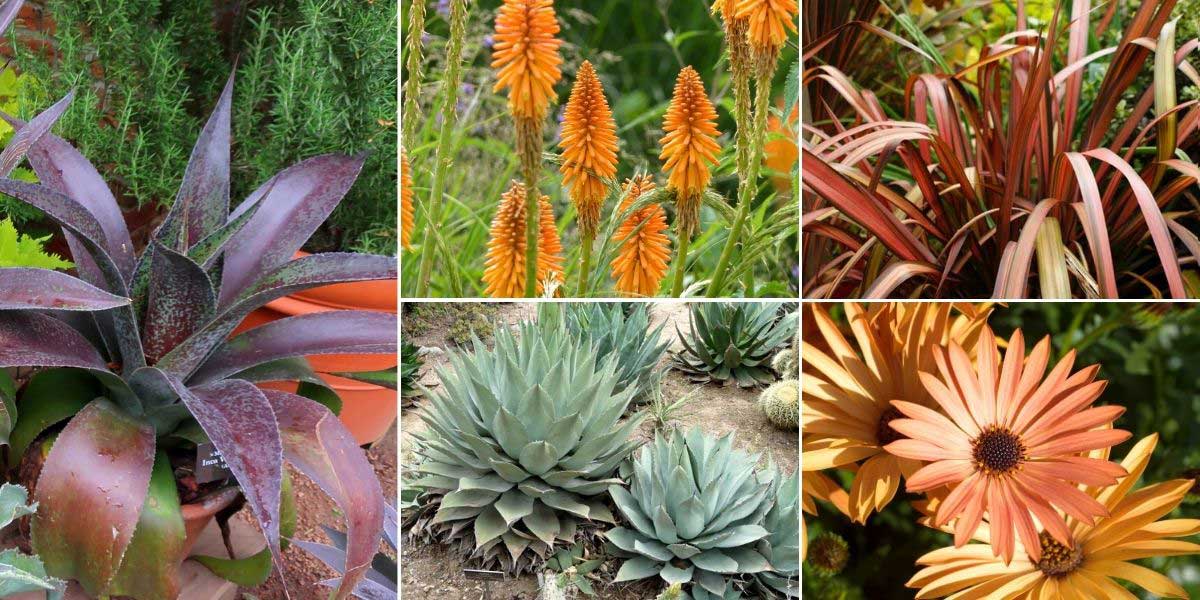
Mangaves are perfect for creating an exotic-style garden! Mangave ‘Inca Warrior’ (photo cultivar413), Kniphofia ‘Fiery Fred’, Phormium ‘Pink Panther’, Agave havardiana, and Osteospermum ‘Cape Daisy Terracotta’
In a cooler region, if you grow Mangave in pots, you can create a composition with other succulents: Echeveria, Sedums, Houseleeks (Sempervivum)… You can also place it on your terrace alongside other exotic and tender plants that need to be overwintered. You just need to bring them under cover at the same time in autumn, then take them out again in spring. Consider Strelitzia reginae, Gloriosa superba, Aloe striatula, Agaves, and palms like Chamaerops humilis… Don’t hesitate to plant Osteospermum alongside them to add colour! You can also plant around them a lush backdrop with hardy exotic plants that can stay in place all year round. For example, discover Cylindropuntia imbricata, a hardy cactus down to -15 °C, and Opuntia: some species can withstand temperatures as low as -20 °C! Also consider Agaves, Sedums, Houseleeks, Musa basjoo, Phormiums…
→ Discover more ideas for pairing with Mangave in our advice sheet!
Useful resources
- Our sheet “Cacti and Outdoor Succulents: Planting, Growing and Maintaining”
- To pair with Mangaves, discover our entire range of cacti and succulents
- Our advice sheet Choosing a Mangave.
- Subscribe!
- Contents































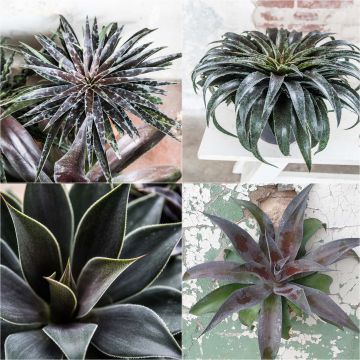
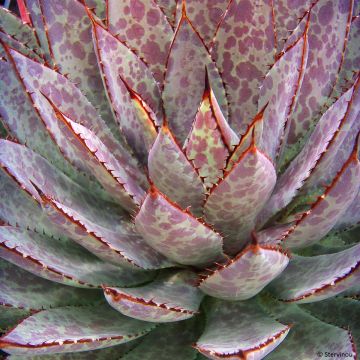





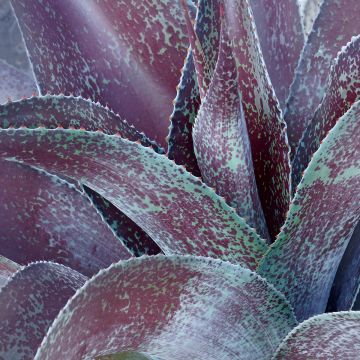
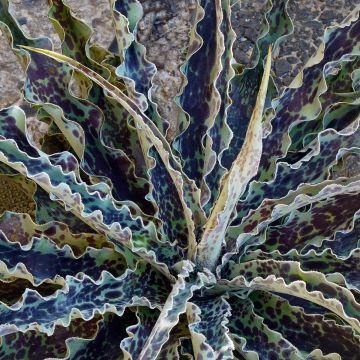
Comments